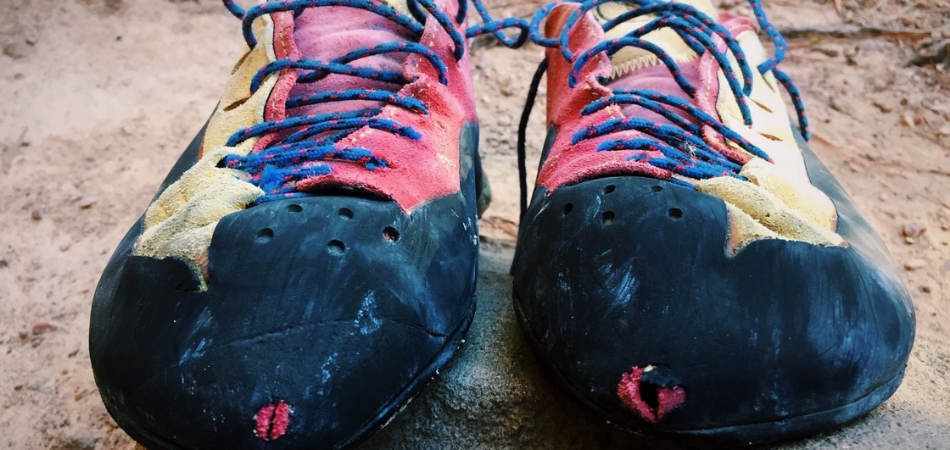Climbing shoes can be quite expensive, and it’s always frustrating when your relatively new climbing shoes develop holes in the toes – even a small hole can dramatically affect the performance of your shoes despite the rest of the shoe being in perfect condition. So, how do you fix holes in rock climbing shoes?
While you can attempt to patch your climbing shoes yourself, this will likely be a very temporary fix. The best way to truly fix a hole in your climbing shoe is to have them professionally resoled, and, if necessary, have the rand repaired as well.
In this article, we’ll look at the different ways that climbing shoes can be repaired, from DIY emergency patches to professional repair. For the purpose of this article, we’ll be looking primarily at the most common area that holes occur in climbing shoes, which is in the rubber-covered toe area.

Patch It Yourself
If your shoes suddenly blow out while you are at the crag and you don’t have the option to initiate a professional repair, you can attempt to patch a hole in your shoe. This can be done with whatever you have on hand, whether that’s a piece of duct tape, Seam Grip, Shoe Goo, a bike tire repair kit, rubber cement, etc.
Patching a hole will likely only hold for a short time, and won’t actually repair the shoe, so the damage will probably continue to get worse. However, it can allow you to finish out a climbing day or tide you over until you can get the shoes repaired.
Professional Repair
Professional resoling is the best option for repairing holes in the toes of your climbing shoes. To understand the repair process, it’s important to first understand the different parts of a climbing shoe. The rand is the thin layer of rubber that goes all the way around the front of the toe box and often covers the top of the shoe as well. The sole is thicker rubber that covers the bottom of the shoe, coming up over the rand around the edges of the shoe.

When the sole starts to get worn down on the toe, the rand is exposed. If you continue to climb in the shoes, the rand will eventually wear through as well, exposing the interior shoe material. This will quickly wear through, creating a hole that you can see through and potentially altering the shape of the shoe.
If you send your climbing shoes in to be resoled before the rand is worn down, you will only need a resole. If the rand and the sole are worn down, both elements will need to be repaired. And, if there is an actual hole all the way through the shoe, stitching might be required in addition to rand repair and resoling.
The wear on climbing shoes tends to only affect the toe and the first few inches on either side of the foot. As such, it’s usually possible to resole only part of the shoe, which is generally called a 1/3 or half resole. If the entire sole is worn down, a resoler might replace the entire sole.
Some professional resolers can get the manufacturer’s original rubber parts, which are perfectly sized and trimmed to shape for the specific model and size of your shoe. Others simply use sheets of rubber which they trim down to size by tracing your shoe.
Resolers can either grind off some or all of the rubber or completely peel off the sole (for a full resole) in order to replace it. The new piece is glued into place and pressed and molded to the shoe with a machine, before the edges are trimmed down and shaped into a new edge.
Cost of Professional Repairs
Getting a pair of climbing shoes professionally resoled usually costs around $40-$50, which makes it a much cheaper option than buying a new pair of shoes in most cases. Depending on when you get the shoes resoled, how much you climb, and how intensely you climb, resoling can give you an extra 3-9 months of use out of a pair of shoes. Plus, you can resole your shoes multiple times and keep using them until they are completely worn out.
However, be aware that resoling takes time and you often will need to ship your shoes to the resoler, who will repair them and then ship them back. Many climbers will have at least two pairs of shoes at any given time so in case one needs to be resoled, they have another pair that they can use.
Replace the Shoes
If you leave the repair too late, it might be cheaper and more efficient to simply purchase new shoes, especially if you shop sales or buy a pair of lightly used shoes.
Frequently Asked Questions (FAQs)
When should you resole climbing shoes?
It’s best to resole climbing shoes before the rand gets worn down, although it is possible to have the rand repaired and the shoes resoled, or to stitch gaping holes closed and then repair the rand and sole. But, the longer you wait, the more expensive and time-consuming the repair will be, and you run the risk that the shoe shape will be permanently altered.
How many times can you resole climbing shoes?
Generally, climbing shoes can be resoled several times – until they lose their shape completely or are otherwise so worn out and stinky that they just aren’t useful anymore. Again, it depends on how diligent you are with resoling and how hard you are on the shoes.
